Sri Lanka Navy
The Sri Lanka Navy (SLN) (Sinhala: ශ්රී ලංකා නාවික හමුදාව, romanized: Śrī Laṃkā nāvika hamudāva; Tamil: இலங்கை கடற்படை, romanized: Ilaṅkai kaṭaṟpaṭai) is the naval arm of the Sri Lanka Armed Forces and is classed as the country's most vital defence force due to its island geography and is responsible for the maritime defense of the Sri Lankan nation and its interests. The role of the Sri Lanka Navy is to conduct operations at sea for the defence of the nation and its interests and conduct prompt and sustainable combat operations at sea in accordance with the national policies.[2]
| Sri Lanka Navy | |
|---|---|
| Sinhala: ශ්රී ලංකා නාවික හමුදාව Tamil: இலங்கை கடற்படை | |
 Emblem of Sri Lanka Navy | |
| Founded | 9 December 1950 |
| Country | |
| Type | Navy |
| Role | Naval and Maritime Defence |
| Size | 54,000,[1] 225+ Ships with additional 4 to be commissioned. |
| Part of | Sri Lankan Armed Forces |
| Headquarters | SLNS Parakrama, Colombo |
| Motto(s) | Sinhala: රට වට බැඳි රන් වැට Rata Wata Baņdi Ran Wéta English:"The golden fence around the country" |
| Colours | Navy blue and white |
| Anniversaries | Navy Day: 9 December |
| Engagements | World War II 1971 JVP Insurrection Insurrection 1987–89 Sri Lankan Civil War |
| Decorations | Military awards and decorations of Sri Lanka |
| Website | www |
| Commanders | |
| Commander-in-Chief | President Gotabaya Rajapaksa |
| Commander of the Navy | Vice Admiral Nishantha Ulugetenne |
| Chief of the Naval Staff | Vacant |
| Deputy Chief of the Naval Staff | Rear Admiral Kapila Samaraweera |
| Notable commanders | Admiral of the Fleet Wasantha Karannagoda Admiral W.W.E.C. Fernando † Admiral Thisara Samarasinghe Admiral Ravindra Wijegunaratne |
| Insignia | |
| Naval Ensign | 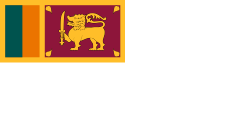 |
| Naval Jack | 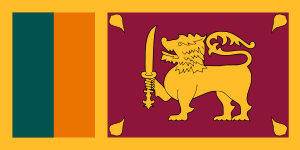 |
| Sri Lanka Navy |
|---|
 |
| Components |
| History |
| Ships |
|
| Personnel |
Sri Lanka, situated in the middle of major sea lanes passing through the Indian Ocean, was always a magnet for seafarers and has a long history of naval campaigns. The current Sri Lankan Navy was established on 9 December 1950 when the Navy Act was passed for the formation of the Royal Ceylon Navy. The roots of the modern Sri Lankan Navy date back to 1937 when the Ceylon Naval Volunteer Force was established, which was renamed and absorbed into the Royal Navy as the Ceylon Royal Naval Volunteer Reserve during World War II. The current name Sri Lanka Navy was constituted in 1972 when Sri Lanka became a republic and the introduction of new constitution.
In recent years it has played a key role in the Sri Lankan Civil War, conducting surveillance and patrol, amphibious and supply operations. During the war, the navy moved from a small force focused on coastal patrols to a large combat force concentrating on asymmetric naval warfare capable of amphibious and land operations in support of counter-insurgency operation that progressed into engagements of a new form of littoral zone warfare. It carried out expeditionary deployments in the Indian Ocean in order to intercept rogue arm shipments on the high seas. The navy has its own elite special forces unit, the Special Boat Squadron.
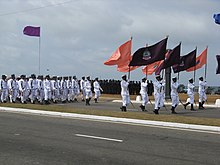
The professional head of the navy is the Commander of the Navy, currently Vice Admiral Nishantha Ulugetenne.[3] The commander-in-chief of the Sri Lankan Armed Forces is the President of Sri Lanka, who heads the National Security Council through the Ministry of Defence, which is the highest level of military command and procurement for the armed forces.[4] Operations of the Sri Lanka Navy are coordinated with the other armed forces by the Joint Operations Command. The Sri Lanka Navy has five Offshore Patrol Vessels, two missile boats, 12 patrol boats, more than 35 fast attack craft, six landing ships/craft and many littoral craft, along with six auxiliary vessels. Its personnel number 48,000 of whom approximately 15,000 are deployed for shore duties.[1]
History
The Beginning and World War II
In January 1938 the Ceylon Naval Volunteer Force (CNVF) was created with Commander W.G. Beauchamp as Commanding Officer under ordinance No I of 1937. On 31 August 1939 at the out set of World War II, the CNVF was mobilised for war duties. Three years later, the CNVF was offered to, and accepted by the Royal Navy (RN) as a Volunteer Reserve, the Ceylon Royal Naval Volunteer Reserve (CRNVR). It continued under Royal Navy operational and administrative command until March 1946. With the end of the war, it reverted to Ceylon Government control, though yet CRNVR in name. In the 1939–1946 period, the CRNVR carried out several operational duties, mainly at sea. Cutting its teeth on the Port Commission tugs Samson and Goliath, it later manned and operated trawlers and Antarctic whalers converted as minesweepers and fitted out with guns, submarine detection equipment and anti-submarine weaponry. They were HMS Overdale Wyke (the first ship to be purchased by the Government of Ceylon), HMS Okapi, HMS Semla, HMS Sambhur, HMS Hoxa, HMS Balta and HM Tugs Barnet and C 405. In addition the CRNVR manned several Motor Fishing Vessels (MFV), Harbour Defence Motor Launch (HDML) and miscellaneous auxiliary vessels. All were manned exclusively by CRNVR personnel. These ships were meant to sweep and guard the approaches the harbours but were often used on extended missions outside Ceylon waters. In the course of these operations, the ships came under enemy fire, recovered essential information from Imperial Japanese aircraft that were shot down, sailed to Akyab (modern Sittwe) after the Burma front was opened in two FMVs for harbour duties, and were called upon to accept the surrender of the Italian sloop Eritrea and escort her to the Colombo port with a prize crew on board.
Royal Ceylon Navy
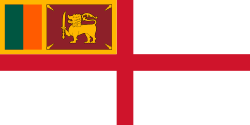
After independence from British rule in 1948 the government believed an island country should possess a strong navy to be its first line of defence. Therefore, on 9 December 1950 the Royal Ceylon Navy was created with Ceylon Royal Naval Volunteer Reserve forming the nucleus. The first warship was commissioned HMCyS Vijaya, an Algerine-class minesweeper, ex-HMS Flying Fish along with other patrol boats and tugs. Later the fleet was expanded with, HMCyS Parakram, another Algerine-class minesweeper (ex-HMS Pickle), two Canadian-built "River" class frigates HMCyS Mahasena (ex-HMCS Orkney, Violetta and ex-Israeli ship Mivtach), HMCyS Gajabahu (ex-HMCS Hallowell, ex-Israeli Misnak) and oceangoing tug (ex-HMS Adept). During this time the navy took part in several joint naval exercises and a goodwill mission to the Far East. However, the expansion of the navy was dramatically halted when the captain of the navy, who was relieved of command at the time, was implicated in the 1962 Ceylonese coup d'état attempt. The navy suffered a great deal as result of the governments retribution that followed, with several of its ships sold off, reduced its size by stoppage of recruitment of officers cadets and sailors for over seven years, the loss of important bases and barracks and the stoppage of training in England. Two batches of 300 ratings were recruited in 1966 and 1969. As a result, in 1971 the navy was poorly equipped and short of personal when the 1971 JVP Insurrection broke out. SLN was not capable of putting ships to sea due to a lack of seagoing units and the navy being called to mount shore duty initially to defend ports and thereafter offensive combat operations against the insurgents. During the insurrection navy suffered its first combat casualties went on to man detention centres to rehabilitate surrendered insurgents after it was crushed in a few months. Sri Lanka, however, had to rely on the Indian Navy to established an exclusion zone around the island.
Navy of the Republic

In 1972 the "Dominion of Ceylon" became the "Democratic Socialist Republic of Sri Lanka" and the Royal Ceylon Navy became the Sri Lanka Navy. The ensign, along with the Flag Officers' flags, were redesigned. The term "Captain of the Navy", introduced in the Navy Act, was changed to "Commander of the Navy", in keeping with the terminology adopted by the other two services. Finally, "Her Majesty's Ceylon Ships" (HMCyS) became "Sri Lankan Naval Ships" (SLNS).
Based on its experiences in the late 1970s the navy began rebuilding its strength with the gift of Shershen-class torpedo boats from the USSR and acquisition of five Type 062-class gunboats from China to carry out effective coastal patrolling and carried out several cruises to regional ports. New bases were established to counter smuggling operations in the coastal areas. Five inshore patrol crafts were ordered from Cheverton, while six coastal patrol craft were built by the Colombo Dockyards.
Civil war
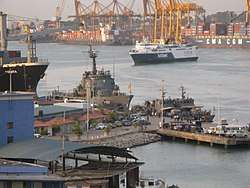
At the begin of the civil war in the 1980s the navy found itself poorly equipped to face the new threats the LTTE created. It found itself engaging in anti-smuggling operations to count LTTE gun running between India and Sri Lanka. As the larger gun boats proved ineffective against faster small boats used by the LTTE with outboard motors, the navy began deploying small boats with waterjets and inshore patrol boats armed with machine guns to police its waters. The LTTE responded with mounting machine guns and attacking the navy boats. This began an asymmetric war at sea, taking place in the primarily in the coastal waters among small boats of the navy and the LTTE naval arm the Sea Tigers. The decades long conflict saw the escalations of the size, fire power and speed with new techniques developed by both sides such as the used sea tigers using sophisticated suicide crafts against naval vessels. The navy acquired in the late 1980s Israeli Dvora-class fast patrol boats which it designated as Fast Attack Crafts (FAC). The FACs of the Fast Attack Flotilla became the work horse of the navy offensive and defensive operations. In the 1990s and 2000s Super Dvora class boats were added and a locally built Colombo class was introduced in larger numbers. These proved highly successful in limiting the LTTE's use of the seas.
During the war the navy increased its fleet of larger vessels by introducing two locally built Jayasagara class offshore patrol vessels. It did suffer the loss of several ships in the 1990s to sea tiger attacks by suicide crafts such as in the sinking of SLNS Sagarawardena and SLNS Ranaviru and the use of suicide frogmen such as in the bombing of SLNS Sooraya and SLNS Ranasuru. Due to the treat posed by the sea tigers the navy had to undertake convoy duty to escort shipping to the Jaffna peninsula to which all land routes were controlled by the LTTE. In order keep supply lines open to Jaffna, the navy employed several auxiliary ships. It also deployed auxiliary ships to support FACs.
In the early 80s a land combat force was created which at first limited itself to base defence and as its numbers increased took part in offensive operations against the LTTE along with the Sri Lankan Army. An elite naval special forces unit called the Special Boat Squadron was created in the late 1980s based on the British Special Boat Service.
In order to support ground operations of the army landing ships and boats were acquired. In early 1990s the SLN carried out injunction with the army its first amphibious operation code named Operation Sea Breeze followed by the larger Operation Balavegaya a year later and on the seas it began an aggressive clamp down on LTTE actives including gunrunning. In 1992, Admiral W.W.E. Clancy Fernando, the commander of the navy was assassinated by a suicide bomb attack by the LTTE.
The mid 1990s saw an slow expansion of larger fleet units with newer Type 062-class gun boats and a Haiqing class submarine chaser being added to the fleet to intercept arms shipments destine for the tigers within Sri Lankan tensorial waters. In 2000 the Navy started a fleet air arm (FAA) by acquiring a HAL Chetak from India to expand its surveillance capability by operating from newly acquired Offshore Patrol Vessels. During the same time conventional warfare capability was increased by the addition of Sa'ar 4-class missile boats.
Following the resumptions of hostilities between the government of Sri Lanka and the LTTE since early 2006, the navy took up an active role in limiting the LTTE's use of the seas. This resulted in several major sea battles curring the course of 2006, 2007 and 2009. Most significant of the events during this time were the interception and sinking of several large cargo ships that were bringing illegal arms shipments to the LTTE in the Indian Ocean in international waters. These naval operations have proven the blue water capability of the Sri Lankan Navy.
During the war the navy, along with the army developed its own weapons development programmes to produce and maintain weapon systems suited for indigenous requirements in collaboration with Colombo Dockyard which included the Jayasagara class, Colombo class and the Ranavijaya class; while the navy designed and developed the Arrow class.
Post war
.jpg)
With the end of the civil war, the navy has begun reorienting itself for the future defence of the island. This has led to force redeployment, training exercises and transfer of certain duties to the newly formed Sri Lanka Coast Guard. In the post war years the navy has expanded it maritime operations to fisheries control and counter human trafficking. Operations to counter illegal poaching by Tamil Nadu fishermen have led to allegations that personnel from the Sri Lanka Navy have attacked more than twelve fishermen, two of whom have died, in a series of disputes.[5][6] Australia transferred two Bay-class patrol boats to the Sri Lanka Navy, following its Prime Minister's visit to the island for the Commonwealth Heads of Government Meeting in November 2013.[7] The first of these vessels was delivered in April 2014.
Blue water navy
.jpg)
Expanding its blue water capability the navy began commissioning larger fleet assets equivalent to Patrol frigates, which it termed as Advanced Offshore Patrol Vessels. In April and August 2018 two 105m long vessels of the Saryu-class were commissioned. Built by Goa Shipyard on order to the Sri Lanka navy, these were the largest purpose built ships for the Sri Lanka Navy.[8]
In 2017, SLNS Sayurala took part in Southeast Asian Nations (ASEAN) International Fleet Review 2017 in Thailand. This is the longest foreign tour (21 days) an SLN Ship undertook after the year 1965 with 127 sailors including 18 officers.[9] This followed in 2018 by SLNS Sagara which sailed to Indonesia to attend the Multilateral Naval Exercise “Komodo” and “International Fleet Review” (IFR) 2018, while SLNS Samudura and SLNS Suranimala sailed to India to take part in Milan.[11] The navy participated in Exercise RIMPAC for the first time in 2018, sending a contingent of marines to the international maritime exercise.
In August 2018, the navy took over a Hamilton-class high endurance cutter which was transferred to the Navy from United States. Commissioned in June 2019 as an Advanced Offshore Patrol Vessel, it became the largest combat vessel in the Sri Lankan navy at 3250 tonnes and second former United States cutter in its service.[13]
In June 2019, the navy took over a Type 053H2G frigate which was transferred to the Navy from China. It will be armed with dual Type 79 100 mm naval guns and two Type 76A dual-37 mm anti-aircraft guns to function as an Offshore Patrol Vessel.[14][15]
Major combat operations
Apart from continued deployments at sea the navy has played a significant role in supporting all major operations carried out by the Army including several amphibious operations.
|
|
Current deployments
As of present, most of the Sri Lankan Navy is deployed for domestic defence with the end of combat operations, while foreign deployments are carried out from time to time.
Domestic
Due to the Sri Lankan Civil War the navy has been on a constant mobilized (including reservist) state since the 1980s (except for a brief period from 2002 to 2005). The majority of the naval units both at sea and ground-based are deployed in the North and Eastern provinces of the country, as well as in other parts of the country. The security of all major ports of the country is the responsibility of the navy, due to terrorist activity.
Foreign
- Haiti - Since 2004 navy personal have been attached to the Sri Lankan contingent of the United Nations Stabilization Mission in Haiti.[16]
- Indian Ocean - In 2007 and 2008 the navy carried out anti-arms smuggling operations in international waters in the Indian Ocean, sinking 6 rogue merchant ships smuggling arms for the LTTE.
Organisation
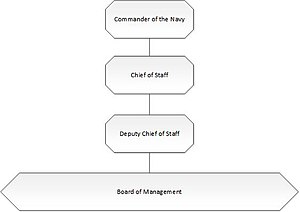
The professional head of the navy is the Commander of the Navy (C of N) who reports directly to the Minister of Defence. The Commander of the Navy exercises operational and administrative control of the Navy from Naval Headquarters in SLNS Parakrama, Colombo. He is assisted by the Chief of Staff (C of S); who along with Directors General and Directors comprise the Board of Management (BOM) and Board of Directors (BOD) of the Sri Lanka Navy.
Leadership
| Post | Rank | Incumbent |
|---|---|---|
| Commander of the Navy | Vice Admiral | Nishantha Ulugetenne |
| Chief of Staff | Rear Admiral | Vacant |
| Deputy Chief of Staff | Rear Admiral | Kapila Samaraweera |
Board of Management
The following posts make up the Board of Management:[17]
- Director General Operations
- Director General Health Services
- Director General Logistics
- Commandant Volunteer Naval Force
- Director General Budget & Finance
- Director General Personal
- Director General Administration
- Director General Electrical and Electronic Engineering
- Director General Training
- Director General Engineering
- Director General Civil Engineering
- Director General Services
- Naval Assistant to The Commander of The Navy
Commands
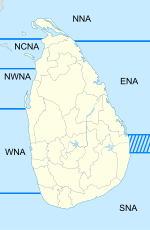
The Navy has seven commands known as Naval Area Commands, each under the control of a flag officer for effective command and administrative control. This is in order to efficiently maintain all ships, crafts and vehicles; and to ensure the operational readiness of commands and units each area shall have its own harbour/ base, repair and refitting facilities, signal centres, logistic, civil engineering and medical facilities.
Seven Naval Area Commands (see image to the right)
- Northern Naval Area (NNA)
- North Central Naval Area (NCNA)
- North Western Naval Area (NWNA)
- Western Naval Area (WNA)
- Southern Naval Area (SNA)
- Eastern Naval Area (ENA)
- South Eastern Naval Area (SENA)
Units
- 3rd Fast Gun Boats Squadron (3 FGS)
- 4th Fast Attack Flotilla (4 FAF)
- 7th Surveillance Command Squadron
- Special Boat Squadron
- Rapid Action Boat Squadron
Branches
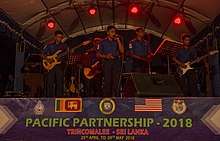
Sri Lanka Navy consists following branches to which personal are attached to;
- Executive Branch
- Navigation and Direction
- Communications
- Gunnery
- Missiles
- Anti-Submarine Warfare (ASW)
- Diving
- Hydrography
- Engineering Branch
- Medical Branch
- Logistics Branch
- Electrical & Electronics Engineering Branch
- Naval Patrolman Branch
- Information Technology Branch
- Musical Branch
- Legal Branch
- Provost Branch
Training
.jpg)
General Sir John Kotelawala Defence University (KDU) formed in 1981 and situated in Ratmalana, fourteen kilometers south of Colombo, is Sri Lanka's only university specialising in defence studies. Apart from postgraduate defence studies each year, approximately fifty cadets from all three services are admitted to the university (aged 18–22) to participate in a three-year programme of under graduate studies.[18]
Senior officers of the ranks of Lieutenant Commander and Commander follow the Command and Staff Course at the Defence Services Command and Staff College (DSCSC) at Batalanda, Makola which was established in 1997 as the Army Command and Staff College and the Junior Staff Course at the Naval & Maritime Academy. In addition KDU conducts Masters Of Science (Defence Studies) degree for the senior officers of Sri Lanka Navy. In addition KDU conducts Masters Of Science (Defence Studies) degree for the officers of navy. The navy continuous to send its senior officers for overseas training, specially for defense college.
Basic officer training is carried out at the Naval & Maritime Academy at the SLN Dockyard in Trincomalee and short/specialised officer training is conducted at the SLNS Gemunu, Welisara. This training includes theoretical aspects covered at the training institute followed by a practical exposure on board the Sri Lanka Navy fleet at sea. The Naval & Maritime Academy also has specialist schools for training areas such as ASW, diving, medicine, combat, NBCD and sniper. It also conducts the Junior Naval Staff Course for staff officers and the Long Logistics Management Course (LLMC) for logistics officers of the navy.
Basic training for new recruits (approximately six months) are conducted at Advanced Naval Training Centre, SLNS 'Nipuna'; Naval Institute of Technology, SLNS 'Thakshila', Welisara; and at Naval Recruit Training Centres at several shore establishments. This basic training will be followed by on-the-job training on-board fleet units and at shore establishments. Combat Training School at SLNS 'Pandukabaya' conducts combat training for Naval Patrolmen.
Additional training is carried out in UK, India, Pakistan, Australia.
- Main training establishments,
- Naval & Maritime Academy - SLN Dockyard
- Advanced Naval Training Centre - SLNS Nipuna
- Naval Artificer Training Institute - SLNS Thakshila
- Naval Recruit Training Centre - SLNS Shiksha
- Naval Recruit Training Centre/Combat Training School - SLNS Pandukabaya
Current Fleet
The Sri Lankan Naval fleet consists of above fifty combat, support ships and inshore patrol craft, with most originating from the United States, China, India, Israel and Sri Lanka.[19]
Ships
| Type | Vessels | Image |
|---|---|---|
| Advanced Offshore Patrol Vessels equivalent to traditional patrol frigates | .jpg) | |
| Offshore Patrol Vessels Deployed on the high seas to carry out surveillance and interception of illegal arms smuggling and to monitor naval activity within the EEZ. |
|
.jpg) |
| Fast Missile Vessels | added to the SLN in 2001 when two Israeli Saar 4 class missile boats were acquired. These vessels, which are referred to as the Nandimithra class and are equipped with Gabriel II anti-ship missiles, increased the SLN's conventional warfare capability and provide a multi-role platform for different operations undertaken by the navy.[27] | .jpg) |
| Fast Gun Boats (FGB) | carry out a multi-role missions from coastal patrols to shore bombardment in support of amphibious operations. FGBs consist of ships from the Chinese Lushun class, Haizhui class and Shanghai II class.[28][29] | - |
| Patrol Boats | Bay-class patrol boats are the latest type of craft to be added to the fleet. They were given to Sri Lanka by the Australian government in 2013, to help the Sri Lanka Navy's efforts to reduce smuggling and other illegal trafficking. The first of these was delivered in April 2014. They were commissioned in July 2014 as SLNS Rathnadeepa and SLNS Mihikatha. | - |
| Fast Attack Craft | They are primarily deployed in offensive operations for the denial of sea, they were also used for defensive operations to prevent Sea Tiger suicide craft from attacking both naval and civilian ships by operating as escorts. There are several classes of FACs in SL Navy.
|
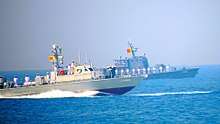 |
| Inshore Patrol Craft | Inshore Patrol Craft are small vessels (14 meters long) which are capable of operating inshore as well as for beaching. They are capable of speeds in excess of 30 knots and are used for small boat operations, harbour defence and amphibious operations.[19] | - |
| Littoral Attack Craft | Littoral Warfare Craft are small (7 meters long) and highly manoeuvrable Arrow class attack speedboats. They also have a high degree of firepower for vessels their size. Introduced in 2006, these boats are manufactured by the SLN's own boatyard and used by the elite Special Boat Squadron (SBS) and the Rapid Action Boat Squadron (RABS) for small boat operations. | - |
| Amphibious Warfare Vessels | The SLN has several vessels to support amphibious operations it carries out. These include Yuhai class Tank landing ship SLNS Shathi; Ranavijaya class utility landing crafts (Locally built); Yunnan class mechanized landing crafts and an ABS M-10 Utility craft air cushion.[28] |  |
| Auxiliary Vessels | The Navy also has several auxiliary vessels such as fast personal carriers and replenishment ships. Fast personnel carriers are catamarans which were used for both troop and civilian transport, running the gauntlet of LTTE suicide craft. SLNs fleet of non-commissioned underway replenishment ships have been used recently for replenishment at sea in international waters. |
Main Naval Weapons Systems
- Gabriel - Anti-ship missile
- Oto Melara 76 mm naval artillery
- PJ33A 100 mm dual gun naval artillery
- Typhoon - Naval Optronic Stabilized Weapon Platforms
- M242 Bushmaster - 25 mm (25x137mm) chain-fed autocannon
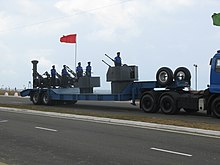
Marine battalion
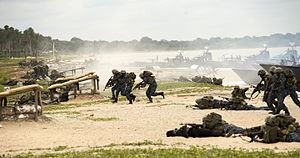
In 2016, the Sri Lanka Navy formed its first battalion of Marines specializing in amphibious warfare. The unit started training under the assistance of the 11th Marine Expeditionary Unit of the United States Marine Corps in November 2016 and received further training from the Commando Regiment of Sri Lanka Army.[30][31][32][33]
The first group consisting of 164 Marines, consisting of 6 officers and 158 sailors, passed out on 27 February 2017 from Naval Base SLNS Barana in Mullikulam in a ceremony attended by the President Maithripala Sirisena, and the Commander of the Navy Vice Admiral Ravindra Wijegunaratne alongside the tri-force Commanders and other senior officers. On July 29, 2017 Vice Admiral Wijegunarathna opened the new Marine Headquarters, SLNS Vidura in Sampoor, Trincomalee.[34][35]
Personnel
Parama Weera Vibhushanaya recipients
The Parama Weera Vibhushanaya is the highest award for valour awarded in the Sri Lankan armed forces. Navy recipients include;
- Lieutenant Commander Jude Lakmal Wijethunge †
- Chief Petty Officer K. G. Shantha †
Notable fallen members
Over 23,790 Sri Lankan armed forces personnel were killed since the start of the civil war in 1981 to its end in 2009, this includes 2 admirals killed in active duty or assassinated.[36] 659 service personnel were killed due to the second JVP insurrection from 1987 to 1990. 53 service personnel were killed and 323 were wounded in the first JVP insurrection from 1971 to 1972.[37] Notable fallen members includes;
- Admiral W.W.E. Clancy Fernando † - Commander of the Navy
- Rear Admiral Mohan Jayamaha † - Commander, Northern Naval Area[38]
Women in the Sri Lanka Navy
Today women are recruited to both the regular and volunteer forces. Although at first limited to the medical branch currently both female officers and rates are able to join any branch of service including the executive branch as well. In 2007 the navy appointed its first-ever female Commodore, Surgeon Commodore Indranee Y. Amarasinghe.[39]
Ranks
The following tables present the military ranks and insignia of the Sri Lanka Navy. These ranks generally correspond with those of Western or Commonwealth Nations militaries, and reflect those of the British warrant officer, non-commissioned officer and enlisted ranks and the Commissioned officer ranks. Sri Lanka does have an Admiral rank, but it is usually only awarded to the Chief of Defence Staff (CDS) or as an honorary rank.
Officers
| Equivalent NATO code | OF-10 | OF-9 | OF-8 | OF-7 | OF-6 | OF-5 | OF-4 | OF-3 | OF-2 | OF-1 | OF(D) and student officer | |||||||||||||||||||||||||
|---|---|---|---|---|---|---|---|---|---|---|---|---|---|---|---|---|---|---|---|---|---|---|---|---|---|---|---|---|---|---|---|---|---|---|---|---|
(Edit) |
|
 _OF-9.svg.png) |
 _OF-8.svg.png) |
 _OF-7.svg.png) |
_OF-6.svg.png) |
_OF-5.svg.png) |
_OF-4.svg.png) |
_OF-3.svg.png) |
_OF-2.svg.png) |
_OF-1b.svg.png) |
_OF-1b.svg.png) |
.svg.png) | ||||||||||||||||||||||||
| Admiral of the Fleet | Admiral | Vice Admiral | Rear Admiral | Commodore | Captain | Commander | Lieutenant Commander | Lieutenant | Sub-lieutenant | Acting Sub-lieutenant | Midshipman | |||||||||||||||||||||||||
Other ranks
| Equivalent NATO code | OR-9 | OR-8 | OR-7 | OR-6 | OR-5 | OR-4 | OR-3 | OR-2 | OR-1 | |||||||||||||||||||||||||||
|---|---|---|---|---|---|---|---|---|---|---|---|---|---|---|---|---|---|---|---|---|---|---|---|---|---|---|---|---|---|---|---|---|---|---|---|---|
(Edit) |
 |
 |
 |
 |
No equivalent |  |
No insignia | No equivalent | No insignia | |||||||||||||||||||||||||||
| Master chief petty officer | Fleet chief petty officer | Chief Petty Officer | Petty Officer | Leading Seaman | Able Seaman | Seaman recruit | ||||||||||||||||||||||||||||||
Future of Sri Lanka Navy
The Sri Lanka Navy set a medium-term fleet expansion goal targeting ten new vessels in its 'Sri Lanka Navy 2025' plan as part of its expansion of blue water operations.[40]
The navy engaged Russia's Zelenodolsk Gorky Plant in talks in early 2017 to acquire a Gepard-class 5.1 frigate.[41] In October 2017, the Government of Sri Lanka approved the purchase of a single Gepard for Rs. 24 billion on a line of credit worth Rs. 20 billion provided by the Russian government.[42][43] However, in June 2018, it has been reported that the purchase of the vessel is not going ahead and the line of credit is expected to be utilized by the Sri Lanka Air Force to purchase helicopters.[44]
Sri Lankan Navy is seeking to get another vessel from the US in 2021 under the Excess Defense Articles Program.[45]
See also
- Military of Sri Lanka
- Commander of the Navy
- Military ranks and insignia of the Sri Lanka Navy
- Fast Attack Flotilla
- Special Boat Squadron
- Rapid Action Boat Squadron
- Naval and Maritime Academy
- Hoods Tower Museum
- Sri Lankan Civil War
References
- Sri Lanka learns to counter Sea Tigers’ swarm tactics, JANE’S NAVY INTERNATIONAL Archived 2011-11-03 at the Wayback Machine, Jane's Information Group
- "About Us". Sri Lanka Navy. Archived from the original on 2007-10-26. Retrieved 2007-10-07.
- "2014/06/29/sec02". sundayobserver.lk. Archived from the original on 2016-10-04. Retrieved 2018-08-16.
- "Commander-in-Chief Completes One Year in Office". Media Center for National Security. 2007-03-08. Archived from the original on 2007-09-28. Retrieved 2007-04-20.
- "Killing of Indian fishermen unacceptable, says Pranab". NDTV.com. Archived from the original on 2013-05-25. Retrieved 2013-03-21.
- "12 fishermen attacked by Sri Lankan navy". The New Indian Express. Archived from the original on 2014-04-27. Retrieved 2013-03-21.
- "Tony Abbott confirms Bay-class patrol boats gift to Sri Lanka to combat people smuggling". ABC News. Archived from the original on 2014-11-20. Retrieved 2014-12-24.
- "India to supply two warships to Sri Lanka". ft.lk. Archived from the original on 2014-12-28. Retrieved 2015-02-26.
- "SLNS Sayurala returns home after successful tour in Thailand". navy.lk. Archived from the original on 2017-12-01. Retrieved 2017-11-30.
- "Navy ships leave for MILAN- 2018". defence.lk. Archived from the original on 2018-06-18. Retrieved 2018-08-16.
- "Secretary Class High Endurance cutter offer to Sri Lanka". http://www.colombopage.com. Archived from the original on 2017-12-01. Retrieved 2017-11-21. External link in
|website=(help) - "China to gift frigate to Sri Lanka to bolster bilateral defence ties". Archived from the original on 2018-09-12. Retrieved 2018-09-12.
- "China to gift a PLAN missile frigate". Archived from the original on 2018-09-16. Retrieved 2018-09-17.
- "Haiti - MINUSTAH - Facts and Figures". un.org. Archived from the original on 2007-08-15. Retrieved 2018-08-16.
- https://www.navy.lk/organization.html
- training Archived 2007-12-13 at the Wayback Machine
- "The official website of Sri Lanka Navy". Archived from the original on 2013-09-23. Retrieved 2014-12-24.
- "The official website of Sri Lanka Navy - His Excellency the President commissions P 626 as SLNS Gajabahu at Colombo harbour". news.navy.lk. Retrieved 2019-06-07.
- "President commissions Navy's new ship". Archived from the original on 2017-08-04. Retrieved 2017-08-04.
- "H.E. the President commissions new AOPV of SL Navy on ceremonial note". Archived from the original on 2017-08-02. Retrieved 2017-08-04.
- "Re-docking of Navy's second Advanced Offshore Patrol Vessel". Archived from the original on 2017-07-29. Retrieved 2017-08-04.
- "Prime Minister commissions 2nd AOPV of Sri Lanka Navy". Archived from the original on 2018-04-23. Retrieved 2018-04-25.
- China to gift frigate to Sri Lanka to bolster bilateral defence ties
- "Forces: Sri Lanka's Big Fleet of Little Boats". strategypage.com. Archived from the original on 2018-08-16. Retrieved 2018-08-16.
- "Haze Gray & Underway: World Navies Today". hazegray.org. Archived from the original on 2017-06-06. Retrieved 2018-08-16.
- SRI LANKA, Institute of Peace and Conflict Studies Archived 2006-10-02 at the Wayback Machine
- "US Marines train recently formed SLN Marine Corps". Archived from the original on 2016-11-23. Retrieved 2016-11-23.
- "Sri Lanka Navy and US Marine Corps personnel engage in a series of training exercises". Archived from the original on 2016-11-28.
- "First ever Marines of Sri Lanka Navy pass out in Mullikulam". Archived from the original on 2017-02-28. Retrieved 2017-02-27.
- "Marine Navy - Sri Lanka". marine.navy.lk. Archived from the original on 2018-08-13. Retrieved 2018-06-06.
- "The official website of Sri Lanka Navy". news.navy.lk. Archived from the original on 2017-03-02. Retrieved 2017-03-08.
- "Marine Navy - Sri Lanka". marine.navy.lk. Archived from the original on 2018-08-13. Retrieved 2018-06-06.
- "Victory's price: 6,200 Sri Lankan troops". News.smh.com.au. 22 May 2009. Archived from the original on 25 May 2009. Retrieved 30 May 2009.
- "The Sunday Times - Special Assignment". Archived from the original on 2016-03-03. Retrieved 2014-12-24.
- Heroes who made the supreme sacrifice Archived 2007-09-30 at the Wayback Machine
- Surgeon Commodore Indranee Y. Amarasinghe Sri Lanka Navy Archived 2007-12-03 at the Wayback Machine
- "Navy to acquire ten new vessels by 2025". island.lk. Archived from the original on 2017-03-13. Retrieved 2017-03-12.
- "Cheetah 5.1 for Sri Lanka". seawaves.com. Archived from the original on 2017-03-13. Retrieved 2017-03-12.
- "Cabinet approves purchase of Rs.24 billion Russian frigate on credit line". sundaytimes.lk. Archived from the original on 2017-10-03. Retrieved 2017-10-16.
- "Zelenodolsk Gepard is ready to pounce on Sri Lanka". realnoevremya.com. Archived from the original on 2017-10-16. Retrieved 2017-10-16.
- "Questions over SLAF's aircraft purchase deals running into a staggering Rs. 64.8 billion | The Sunday Times Sri Lanka". sundaytimes.lk. Archived from the original on 2018-06-10. Retrieved 2018-08-16.
- "New Missions and Stronger Partnerships: How U.S. Excess Defense Articles Help Promote a Free and Open Indo-Pacific Region". United States Department of State. Retrieved 2020-05-13.
_OF-10.svg.png)